Press pliers for plastic pipes: how to choose + instruction on use
For the laying, installation and repair of communication systems made of metal-plastic material, a special tool is used - press tongs for metal-plastic pipes. This device allows you to accurately process parts and provide a reliable, tight and strong connection of all fragments among themselves.
The system, assembled using press tongs, is characterized by long-term operation, guarantees mechanical strength in the joints and does not require subsequent labor-intensive maintenance. We will tell you how to choose a tool and how to correctly apply it in practice. Our care tips will help extend its working life.
The content of the article:
- Varieties of Press Ticks
- Features of a hand crimping tool
- What connect metal-plastic pipes?
- Preparation of pipes for processing by press pliers
- How is pressure testing performed with a hand tool?
- Features of the use of press ticks
- Instrument Safety
- How to care for press pliers?
- Conclusions and useful video on the topic
Varieties of Press Ticks
According to one classification, crimping pliers for plastic and plastic pipes There are three types: manual (mini and standard), hydraulic and electric.
Mini hand clamps are the simplest crimping tool for domestic use. The device has small, compact dimensions and without nozzles weighs about 2.5 kilograms. It fits comfortably in the hand and ensures correct crimping of the coupling on pipes with diameters up to 20 millimeters.
It is completed with a set of several nozzles designed for pipe material of different calibers. Thanks to the presence of axial eccentrics, it allows you to make additional adjustments when excessive play occurs during processing.
The standard manual model has a crimped head made of high strength metal alloy. Convenient, elongated, telescopic handles attached to the head with a gear mechanism help to easily adjust the level of compression force.
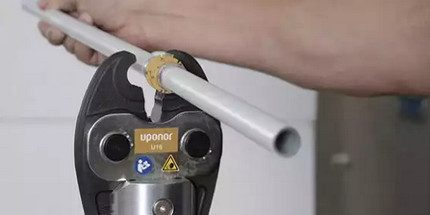
The use of a tool intended for manual connections does not require a person to have specific knowledge or extensive installation experience.
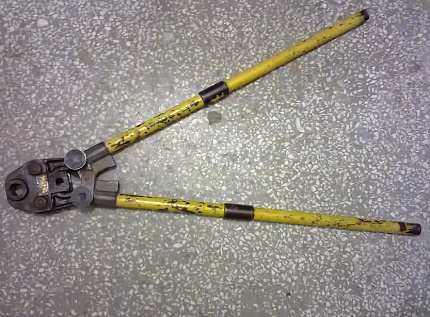
For the implementation of a one-time household repair or installation of the necessary communications made of metal-plastic inside the house, a hand press is simply ideal and easily copes with all the stresses that arise in the process. The kit usually includes additional spacers, which make it possible to crimp pipes of different diameters.
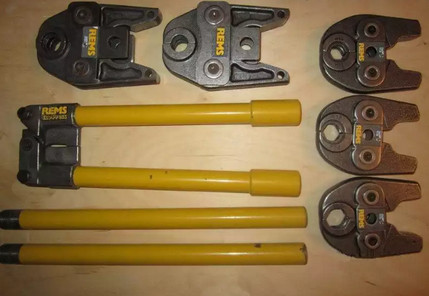
However, for a hand tool there are a number of limitations, and its crimping capabilities apply only to small-caliber material (no more than 26 mm). WITH plastic pipes large size hand pincers do not cope, but in everyday life it is not too important. Indeed, in private houses, cottages and city apartments, standard types of pipes with a small cross section are mainly installed.
On one of the handles of the hydraulic press tongs is a hydraulic cylinder. The output rod is mechanically connected to the crimping head. In the process of bringing the handles together, the piston enters the hydraulic cylinder and creates a working pressure transmitted to the head.
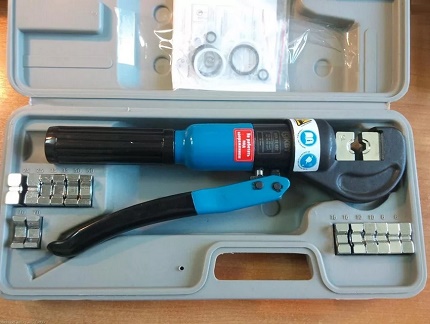
The muscular strength of a person is practically not used, but the device itself is much more expensive than the manual version and needs regular maintenance.
Models with electric drives are small and light in weight, but they are distinguished by their high working capacity and quietly withstand increased operating loads.
When carrying out repair and installation activities, the employee does not have to make significant efforts to complete the task. This significantly speeds up the process, reduces its cost and significantly reduces labor costs.
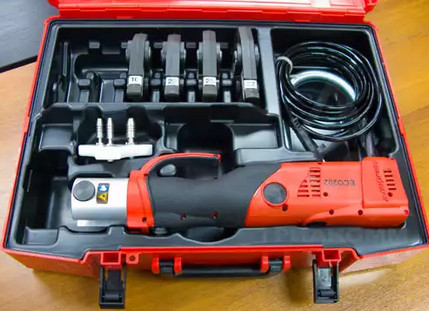
Electric pressing tongs make a clear, even crimp, easily process pipes with a diameter of up to 110 millimeters and operate efficiently when laying large-scale communications. They accelerate the process of forming individual fragments into a common system and are equipped with nozzles that expand the range of pipes available for crimping.
By type of supply, electric press tools for metal-plastic and other pipes are divided into three subclasses:
- rechargeable - receive power from the built-in battery, suitable for use where there is no way to connect to the mains; on one charge carry out from 50 to 100 crimps;
- network - operate from a conventional 220W electrical outlet;
- universal - demonstrate the same efficiency in both modes (battery / outlet).
The only drawback of the model is the rather large dimensions that do not allow comfortable use of the tool in difficult, cramped conditions.
In devices with an electrohydraulic drive, only universal removable heads are used for crimping onto a separate base section of a metal-plastic pipe material. The load during processing spreads over the entire joint area, and the tool itself acts more gently and smoothly. The quality of the joints after such crimping is impeccable.
The choice of a suitable model of press pliers for metal-plastic directly depends on the scale of the proposed work and the diameter of the pipes to be crimped.
Professional plumbers prefer to take electric or hydraulic pliers. The owners of houses and apartments buy manual equipment, as they do not plan any global work related to the installation and laying of metal-plastic communication systems.
Features of a hand crimping tool
In addition to their direct functions, individual models of manual press tongs have some additional functions that facilitate the installation process and facilitate compliance with the rules of basic safety during operation:
- Ops - an expansion option aimed at increasing muscle strength with the help of a progressive four-stage retainer.
- APC - A unique system that controls the correct connection (does not allow to remove the pliers from the pipe until the clamp is completely completed).
- APS - a progressive device for the correct distribution of the applied force depending on the dimensions of the press fitting.
When planning the purchase of manual press tongs for metal-plastic, first determine the diameter of the pipes used, and then, based on these data, they will find out if the store has a tool of the same diameter and intended crimping fittingsused to make the connections.
If you need to compress pipes of different sizes, the maximum section of the part is taken as the basis.A large-diameter tool will also cope with smaller pipes, since additional liners always come in the kit, allowing you to carry out this operation.
The whole process of creating a connection using press tongs involves several standard steps:
What connect metal-plastic pipes?
In the process of laying metal-plastic pipes, special connecting parts are used - fittings. They represent fasteners or nodal branches - crosses, tees, adapters, plugs, etc.
There are two types of these parts - compression and press. To install the former, you need a regular wrench, and for the latter, crimp pliers. WITH assortment of fittings, used for the assembly of metal-plastic pipelines, will familiarize us with the article recommended by us.
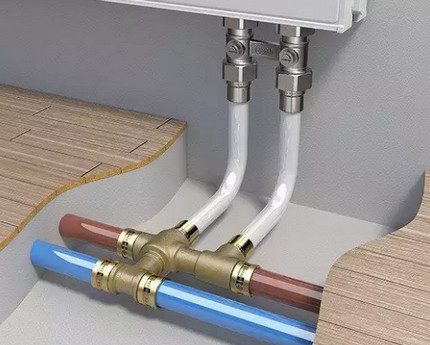
The press fitting is considered the most reliable and does not weaken during operation, minimizing the possibility of leakage in the systems. This method of connection makes it possible to fill the communications with concrete and, if necessary, carry out hidden laying of metal-plastic pipes in walls, floors and ceilings.
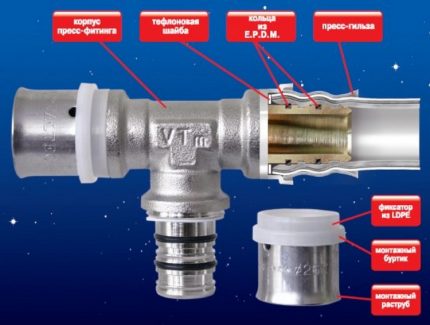
The connection area demonstrates excellent performance, easily withstands pressure several times the maximum permissible pressure in the pipes themselves, exhibits high mechanical strength and reliably serves for many years, without requiring undue attention and time-consuming maintenance measures.
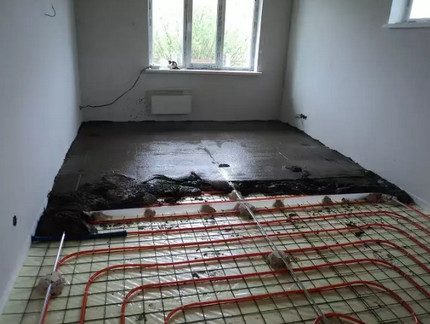
Crimp pliers of any kind are used to install fittings in plastic pipes. With their help, crimping takes place quickly and efficiently, and the result is a clear non-separable connection that almost completely eliminates a breakthrough on the communication line.
When using press fittings, the system turns into a one-piece, non-separable complex. Errors made during the installation process are not subject to correction or repair. To eliminate them, you will have to cut a fragment and install a new communication node.
Another disadvantage is the rather high price of press parts. That is why they are not widely used in everyday life.
Preparation of pipes for processing by press pliers
Immediately before assembly of systems made of metal-plastic, i.e.Before using press tongs and crimping, the tube material is prepared accordingly.
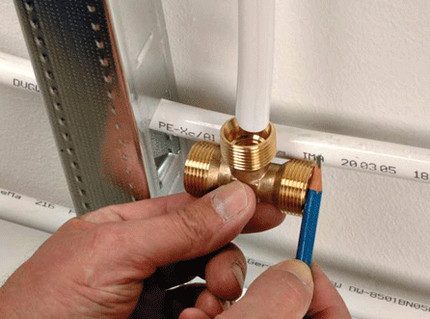
The sequence of actions is relevant for a tool of any type and requires compliance with:
- Using a tape measure from the bay, the required amount of pipe material is measured and marked with a marker where the intended cut will be.
- Scissors for cutting metal-plastic cut off the part of the required length, making sure that the formed edge is as even as possible and makes up a clear right angle with the conditional central axis of the product.
- When using the guillotine tool for work, its lower edge is kept strictly parallel to the surface of the pipe, only slightly pressing the cutting part into the compliant material.
- When trimming is done, the resulting end edges are treated with a calibrator. It corrects and aligns the shape of the cut and gently removes the inner chamfer.
- The crimp sleeve is removed from the fitting and put on the edge of the pipe. The fitting is inserted directly into the slice.
- The end parts of the connection elements are pressed tightly, and the joint area is isolated with a sealing gasket. It protects the material from corrosion and ensures the integrity of the entire system.
- The control of the placement of the pipe in the sleeve is carried out through a circular cutout in the edge zone.
When the appropriate preliminary preparation is completed, begin to use the press tongs and carry out the crimping operation.
How is pressure testing performed with a hand tool?
The process of crimping a metal-plastic pipe with manual press tongs is not complicated, but it requires attention and accuracy. To work, you need an empty, flat surface that allows you to position a pipe segment, connecting fittings and the tool itself.
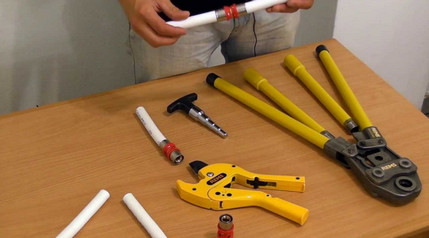
When everything you need is prepared, the press tongs are placed on the table and the handles are pushed apart 180 degrees.
The upper element of the cage is disconnected from the unit and the upper part of the press insert corresponding to the size of the cross-section of the pipe that is currently being processed is inserted into it. The lower half is placed in the lower part of the cage, the remaining empty, and snap the tool.
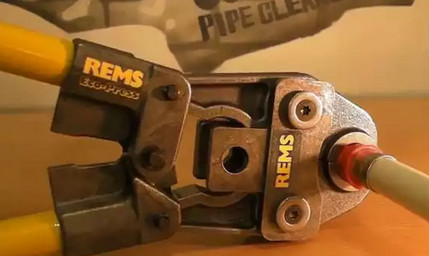
A joint assembly is made up of the pipe and fitting and the structure is inserted into the press tongs, carefully observing that the fitting sleeve is inside the press liner.

After correctly placing the kit from the pipe and fitting in the device, the handles are brought together to the stop and crimping is carried out.
After the operation on the metal, two identical arched bends and two well-visible annular bands should form. And the result will be a clearly and firmly installed and fixed fitting, which will be almost impossible to remove with an improvised working tool.
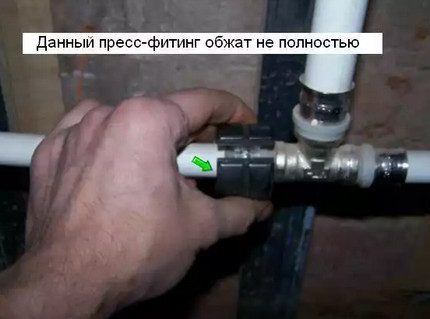
The incorrectly performed work can be determined by a loose, loosely fixed nut, by the presence of an opening more than 1 millimeter wide visible between the metal-plastic pipe and the nut, and by the loose tightening of the nut. If such errors are found, the fitting will have to be cut out of the pipe and reinstalled in its place.
Features of the use of press ticks
Despite the practicality and functionality of press tongs, there are places where it is very inconvenient to use such a tool. Repair and installation professionals say that when working with strobes laid in a false wall or under a suspended ceiling, it is wiser to take not a pliers, but a press gun. It completely eliminates injuries and makes it possible to control the process with one hand.
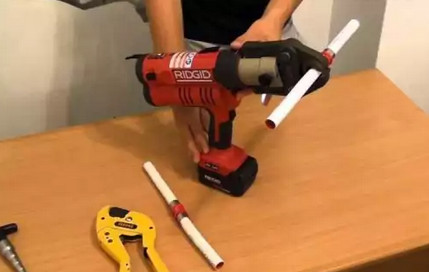
In addition, the tool can be rotated around the butt axis of the pipes, making precise, even and reliable crimping in this way.
Good advice on the production of crimping metal-plastic pipes, tested in practice by plumbers, are given in the next article, the contents of which we advise you to read.
Instrument Safety
The use of press tongs in everyday life does not require specific knowledge or extensive experience. You just need to carefully study the operating instructions and clearly observe everything that is written there.
Do not use the tool in rooms with high humidity. Moisture adversely affects the metal and leads to seizing and incorrect operation of tools.
The crimping process is preferably carried out in comfortable, practical clothes, and hands should be protected with tight construction gloves. To avoid injuries and injuries, parts of clothing and limbs should not be allowed to enter the working mechanism. Following these simple rules will help you to crimp accurately without damaging yourself or the tool.
How to care for press pliers?
In order for the tool to serve reliably for a long time, you need to take care of it. After operation, it is necessary to clean the metal head with a special tool, and then process the screw, the crimping parts of the nozzle with grease.
It is recommended to store the device in a dry place, having previously packed it in a case or a special box, usually sold with the tool.
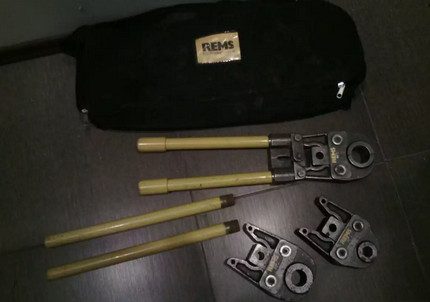
Electric and hydraulic units are somewhat more difficult to maintain and require professional maintenance. How to maintain them in order, you can find out from the passport that came with the equipment.
In addition to press tongs, a pipe cutter will be required in the assembly of a pipeline from metal plastic, especially the choice and application of which given here. We recommend that you read some very useful information.
Conclusions and useful video on the topic
The roller describes in detail how to use manual press tongs for crimping metal-plastic pipes. The author gives useful tips on the operation of the equipment and shares some secrets of the quality processing of parts for their subsequent installation in the water supply and heating systems.
The video is about hydraulics crimping tools. The main advantage of the presented model is the detachable design of the working head.
This allows the use of press tongs even in an uncomfortable place and quickly carry out high-quality crimping of the pipe. The device has a special valve that limits the base pressure.
Electric pressing tongs have a lot of advantages and allow you to quickly carry out a large number of crimping measures. The head makes a complete revolution around its axis and easily adapts to difficult operating conditions.
The disadvantages of the equipment include the impressive weight, the mandatory availability at hand of a power outlet and a rather high cost. They say that for one-time repair and installation work there is no sense in buying equipment of this level. It is better to rent it or even limit yourself to the usual manual model.
Having familiarized with the above information, it will be very simple to choose suitable press tongs even for those who rarely engage in repair and installation work. Additional advice will be given to the customer by sellers already in place at the store.
Buying a nameless tool too cheap is not worth it. He will not be able to provide crimping of proper quality and will quickly fail.
It is better to pay attention to the models released by recognized world brands. They make their products from high-strength modern materials and always provide a guarantee for a certain period of operation, maintenance and professional repair services.
Do you want to share your own experience in assembling pipelines using press tongs? Do you know the technical subtleties that it makes sense to share with site visitors? Please write comments in the block below, ask questions, post thematic photos.

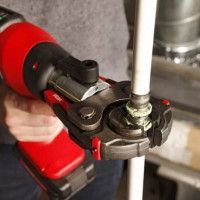 Fittings for plastic pipes: types, applications, an overview of the best manufacturers
Fittings for plastic pipes: types, applications, an overview of the best manufacturers 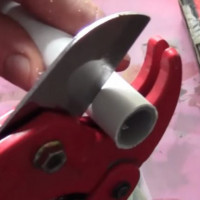 Pipe cutter for plastic pipes: types, which is better to choose and how to use it correctly
Pipe cutter for plastic pipes: types, which is better to choose and how to use it correctly 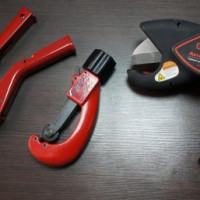 Pipe cutter for plastic pipes: choose the best model + instruction for use
Pipe cutter for plastic pipes: choose the best model + instruction for use 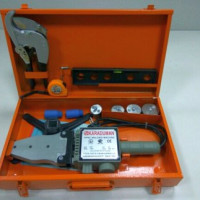 How to choose a soldering iron for polypropylene pipes: tips from professional plumbers
How to choose a soldering iron for polypropylene pipes: tips from professional plumbers 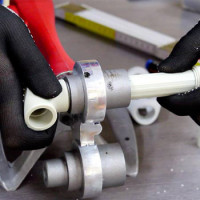 How to choose an iron for welding polypropylene pipes and how to use it correctly
How to choose an iron for welding polypropylene pipes and how to use it correctly 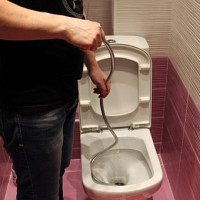 A cable for cleaning pipes: types, how to choose the right + instructions for use
A cable for cleaning pipes: types, how to choose the right + instructions for use  How much does it cost to connect gas to a private house: the price of organizing gas supply
How much does it cost to connect gas to a private house: the price of organizing gas supply  The best washing machines with dryer: model rating and customer tips
The best washing machines with dryer: model rating and customer tips  What is the color temperature of light and the nuances of choosing the temperature of the lamps to suit your needs
What is the color temperature of light and the nuances of choosing the temperature of the lamps to suit your needs  Replacement of a geyser in an apartment: replacement paperwork + basic norms and requirements
Replacement of a geyser in an apartment: replacement paperwork + basic norms and requirements
Branded press pliers are expensive, and if you need to compress several diameters, then buying them is very ruinous. I rented them, it turned out bearable for the money.
And interestingly, it didn’t work out right away right away, I put the oblique fitting and clamped it. Count, messed up, and crimp fittings are expensive. It is necessary to carefully understand and try on before clamping. Because the bias can ruin everything, then you will not pressure the system, there will be leaks.